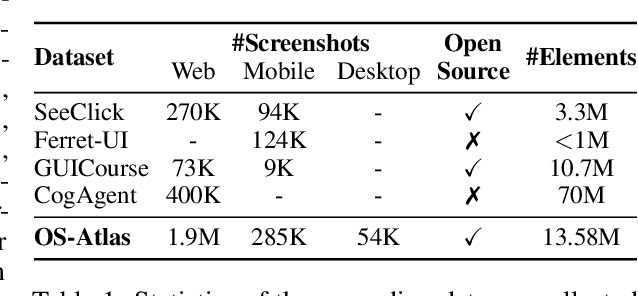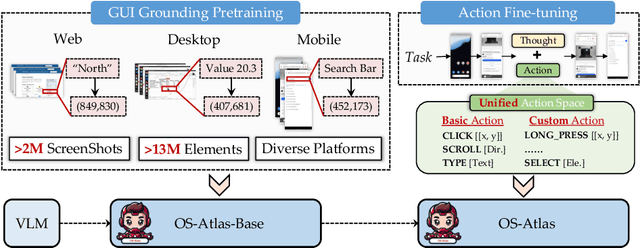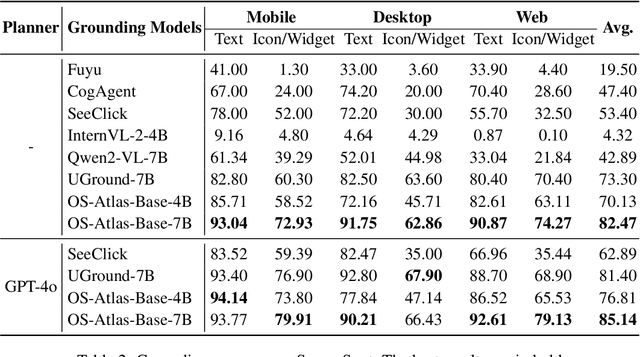Zichen Ding
Breaking the Data Barrier -- Building GUI Agents Through Task Generalization
Apr 15, 2025Abstract:Graphical User Interface (GUI) agents offer cross-platform solutions for automating complex digital tasks, with significant potential to transform productivity workflows. However, their performance is often constrained by the scarcity of high-quality trajectory data. To address this limitation, we propose training Vision Language Models (VLMs) on data-rich, reasoning-intensive tasks during a dedicated mid-training stage, and then examine how incorporating these tasks facilitates generalization to GUI planning scenarios. Specifically, we explore a range of tasks with readily available instruction-tuning data, including GUI perception, multimodal reasoning, and textual reasoning. Through extensive experiments across 11 mid-training tasks, we demonstrate that: (1) Task generalization proves highly effective, yielding substantial improvements across most settings. For instance, multimodal mathematical reasoning enhances performance on AndroidWorld by an absolute 6.3%. Remarkably, text-only mathematical data significantly boosts GUI web agent performance, achieving a 5.6% improvement on WebArena and 5.4% improvement on AndroidWorld, underscoring notable cross-modal generalization from text-based to visual domains; (2) Contrary to prior assumptions, GUI perception data - previously considered closely aligned with GUI agent tasks and widely utilized for training - has a comparatively limited impact on final performance; (3) Building on these insights, we identify the most effective mid-training tasks and curate optimized mixture datasets, resulting in absolute performance gains of 8.0% on WebArena and 12.2% on AndroidWorld. Our work provides valuable insights into cross-domain knowledge transfer for GUI agents and offers a practical approach to addressing data scarcity challenges in this emerging field. The code, data and models will be available at https://github.com/hkust-nlp/GUIMid.
OS-Genesis: Automating GUI Agent Trajectory Construction via Reverse Task Synthesis
Dec 27, 2024Abstract:Graphical User Interface (GUI) agents powered by Vision-Language Models (VLMs) have demonstrated human-like computer control capability. Despite their utility in advancing digital automation, a critical bottleneck persists: collecting high-quality trajectory data for training. Common practices for collecting such data rely on human supervision or synthetic data generation through executing pre-defined tasks, which are either resource-intensive or unable to guarantee data quality. Moreover, these methods suffer from limited data diversity and significant gaps between synthetic data and real-world environments. To address these challenges, we propose OS-Genesis, a novel GUI data synthesis pipeline that reverses the conventional trajectory collection process. Instead of relying on pre-defined tasks, OS-Genesis enables agents first to perceive environments and perform step-wise interactions, then retrospectively derive high-quality tasks to enable trajectory-level exploration. A trajectory reward model is then employed to ensure the quality of the generated trajectories. We demonstrate that training GUI agents with OS-Genesis significantly improves their performance on highly challenging online benchmarks. In-depth analysis further validates OS-Genesis's efficiency and its superior data quality and diversity compared to existing synthesis methods. Our codes, data, and checkpoints are available at \href{https://qiushisun.github.io/OS-Genesis-Home/}{OS-Genesis Homepage}.
SEAGraph: Unveiling the Whole Story of Paper Review Comments
Dec 16, 2024



Abstract:Peer review, as a cornerstone of scientific research, ensures the integrity and quality of scholarly work by providing authors with objective feedback for refinement. However, in the traditional peer review process, authors often receive vague or insufficiently detailed feedback, which provides limited assistance and leads to a more time-consuming review cycle. If authors can identify some specific weaknesses in their paper, they can not only address the reviewer's concerns but also improve their work. This raises the critical question of how to enhance authors' comprehension of review comments. In this paper, we present SEAGraph, a novel framework developed to clarify review comments by uncovering the underlying intentions behind them. We construct two types of graphs for each paper: the semantic mind graph, which captures the author's thought process, and the hierarchical background graph, which delineates the research domains related to the paper. A retrieval method is then designed to extract relevant content from both graphs, facilitating coherent explanations for the review comments. Extensive experiments show that SEAGraph excels in review comment understanding tasks, offering significant benefits to authors.
OS-ATLAS: A Foundation Action Model for Generalist GUI Agents
Oct 30, 2024



Abstract:Existing efforts in building GUI agents heavily rely on the availability of robust commercial Vision-Language Models (VLMs) such as GPT-4o and GeminiProVision. Practitioners are often reluctant to use open-source VLMs due to their significant performance lag compared to their closed-source counterparts, particularly in GUI grounding and Out-Of-Distribution (OOD) scenarios. To facilitate future research in this area, we developed OS-Atlas - a foundational GUI action model that excels at GUI grounding and OOD agentic tasks through innovations in both data and modeling. We have invested significant engineering effort in developing an open-source toolkit for synthesizing GUI grounding data across multiple platforms, including Windows, Linux, MacOS, Android, and the web. Leveraging this toolkit, we are releasing the largest open-source cross-platform GUI grounding corpus to date, which contains over 13 million GUI elements. This dataset, combined with innovations in model training, provides a solid foundation for OS-Atlas to understand GUI screenshots and generalize to unseen interfaces. Through extensive evaluation across six benchmarks spanning three different platforms (mobile, desktop, and web), OS-Atlas demonstrates significant performance improvements over previous state-of-the-art models. Our evaluation also uncovers valuable insights into continuously improving and scaling the agentic capabilities of open-source VLMs.
Let's Be Self-generated via Step by Step: A Curriculum Learning Approach to Automated Reasoning with Large Language Models
Oct 29, 2024



Abstract:While Chain of Thought (CoT) prompting approaches have significantly consolidated the reasoning capabilities of large language models (LLMs), they still face limitations that require extensive human effort or have performance needs to be improved. Existing endeavors have focused on bridging these gaps; however, these approaches either hinge on external data and cannot completely eliminate manual effort, or they fall short in effectively directing LLMs to generate high-quality exemplary prompts. To address the said pitfalls, we propose a novel prompt approach for automatic reasoning named \textbf{LBS3}, inspired by curriculum learning which better reflects human learning habits. Specifically, LBS3 initially steers LLMs to recall easy-to-hard proxy queries that are pertinent to the target query. Following this, it invokes a progressive strategy that utilizes exemplary prompts stemmed from easy-proxy queries to direct LLMs in solving hard-proxy queries, enabling the high-quality of the proxy solutions. Finally, our extensive experiments in various reasoning-intensive tasks with varying open- and closed-source LLMs show that LBS3 achieves strongly competitive performance compared to the SOTA baselines.
RELIEF: Reinforcement Learning Empowered Graph Feature Prompt Tuning
Aug 06, 2024Abstract:The advent of the "pre-train, prompt" paradigm has recently extended its generalization ability and data efficiency to graph representation learning, following its achievements in Natural Language Processing (NLP). Initial graph prompt tuning approaches tailored specialized prompting functions for Graph Neural Network (GNN) models pre-trained with specific strategies, such as edge prediction, thus limiting their applicability. In contrast, another pioneering line of research has explored universal prompting via adding prompts to the input graph's feature space, thereby removing the reliance on specific pre-training strategies. However, the necessity to add feature prompts to all nodes remains an open question. Motivated by findings from prompt tuning research in the NLP domain, which suggest that highly capable pre-trained models need less conditioning signal to achieve desired behaviors, we advocate for strategically incorporating necessary and lightweight feature prompts to certain graph nodes to enhance downstream task performance. This introduces a combinatorial optimization problem, requiring a policy to decide 1) which nodes to prompt and 2) what specific feature prompts to attach. We then address the problem by framing the prompt incorporation process as a sequential decision-making problem and propose our method, RELIEF, which employs Reinforcement Learning (RL) to optimize it. At each step, the RL agent selects a node (discrete action) and determines the prompt content (continuous action), aiming to maximize cumulative performance gain. Extensive experiments on graph and node-level tasks with various pre-training strategies in few-shot scenarios demonstrate that our RELIEF outperforms fine-tuning and other prompt-based approaches in classification performance and data efficiency.
OS-Copilot: Towards Generalist Computer Agents with Self-Improvement
Feb 15, 2024Abstract:Autonomous interaction with the computer has been a longstanding challenge with great potential, and the recent proliferation of large language models (LLMs) has markedly accelerated progress in building digital agents. However, most of these agents are designed to interact with a narrow domain, such as a specific software or website. This narrow focus constrains their applicability for general computer tasks. To this end, we introduce OS-Copilot, a framework to build generalist agents capable of interfacing with comprehensive elements in an operating system (OS), including the web, code terminals, files, multimedia, and various third-party applications. We use OS-Copilot to create FRIDAY, a self-improving embodied agent for automating general computer tasks. On GAIA, a general AI assistants benchmark, FRIDAY outperforms previous methods by 35%, showcasing strong generalization to unseen applications via accumulated skills from previous tasks. We also present numerical and quantitative evidence that FRIDAY learns to control and self-improve on Excel and Powerpoint with minimal supervision. Our OS-Copilot framework and empirical findings provide infrastructure and insights for future research toward more capable and general-purpose computer agents.
 Add to Chrome
Add to Chrome Add to Firefox
Add to Firefox Add to Edge
Add to Edge